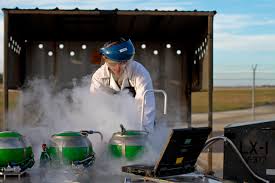Commonly, matter appears in one of the four states: solid, liquid, gas and plasma. State of matter is the distinct form that a matter takes. In extreme conditions, scientists have observed some other states of matter also, but not in everyday life. Air takes the form of gas.

The basic component of all matter is atom which comprises of unique number of protons, neutrons and electrons. Atoms join together to form molecules and molecules together form matter. In solid state, the bonding between molecules is strong and hence matter in solid state has a definite shape. In liquid state, the bonding between molecules is weak compared to that of solids. As a result, a liquid takes the shape of its container. But, a liquid has specific volume. The bonding force between the molecules is least in gaseous state. As a result gases take the shape and volume of the container.
Recently, plasma has also been added to the other three conventional states of matter because of the progress in the field of study of matter at very high temperatures and pressures. Consider the case of sun for example. The atoms themselves break down, electrons get freed from the hold of the nucleus leaving positively charged ion behind. The resultant mixture of neutral atoms, charged ions and free electrons form the plasma state. Plasma is a fluid, similar to liquid or gas, but generates electromagnetic forces.
Air is a mixture of nitrogen, oxygen and other gases. Scientists have developed methods to convert gases into liquids. Gases like, nitrogen, oxygen, hydrogen etc are subjected to cooling to certain temperature and then compressed to very high pressure. The said temperature is called critical temperature. Due to the cooling and compression, the molecules become closer and gas gets converted into liquid. Air, being a mixture of gases can also be converted into liquid state. Under normal atmospheric pressure, air has to be cooled to (-) 200 degree-centigrade and under high pressure to (-) 141 degree-centigrade to convert into liquid.
Joule-Thomson effect is used for the liquefaction of air. As per this effect, expansion into vacuum cools the air. Air from the atmosphere is compressed to a high pressure. This air is then allowed to expand suddenly. This leads to cooling of air to a very low temperature. Air looses all the temperature and the cool air is then compressed again by which it gets converted into liquid.

